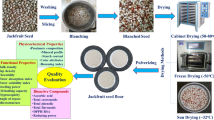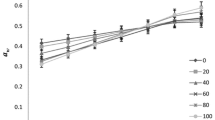Abstract
The aims of this study were determine (1) the chemical composition (2) the physico-chemical properties (3) the fatty acid profile (4) the techno-functional and (5) the antioxidant properties of flours obtained from house cricket (Acheta domesticus) using two different methods of drying. In thermal drying cricket flour (TDCF) and lyophilized cricket flour (LCF) high content of protein (62.68–67.48%, respectively) and fat (24.91–19.32% respectively) was found. This content was higher than found in several cereal or pseudocereal flours such as wheat, oat or quinoa. Both types of flours showed good techno-functional properties (water and oil holding capacity, Swelling capacity, emulsion and foam capacity and stability) with higher values in LCF than TDCF. The values obtained for techno-functional properties were similar to those found for several flours obtained from cereal or pseudocereal of fruits coproducts. In LCF and TDFC the main fatty acid detected were linoleic, oleic and palmitic acids. LCF showed stronger radical scavenging (7.18–2.82 mg Trolox equivalent/g, respectively), reducing (0.24–0.15 Trolox equivalent/g, respectively) and chelating capacity (43.78–32.23 µg EDTA/g, respectively) than TDCF. Due to the protein and fat content, the good techno-functional and antioxidant properties the flours obtained from house cricket could be used as food ingredient in the development of novel foods.
Similar content being viewed by others
References
van Huis A, Van Itterbeeck J, Klunder H, Mertens E, Halloran A et al (2013) Edible insects Future prospects for food and feed security. FAO Forestry Paper, no 171
Myers G, Pettigrew S (2017) A qualitative exploration of the factors underlying seniors’ receptiveness to entomophagy. Food Res Int 10:163–169
Schösle H, De Boer J, Boersema JJ (2012) Can we cut out the meat of the dish? Constructing consumer-oriented pathways towards meat substitution. Appetite 58(1):39–47
Zielińska E, Karaś M, Rybczyńska K, Jakubczyk A (2015) Selected species of edible insects as a source of nutrient composition. Food Res Int 77:460–466
Lensvelt E, Steenbekkers L (2014) Exploring consumer acceptance of entomophagy: a survey and experiment in Australia and the Netherlands. Ecol Food Nutr 53(5):543–561
Rumpold BA, Schlüter OK (2013) Nutritional composition and safety aspects of edible insects. Mol Nutr Food Res 57(5):802–823
AOAC (2000) Official methods of analysis of AOAC international, vol. 1, 17th edition. AOAC International, Gaithersburg A. International, Ed
Robertson JA, Monredon FD, Dysseler P, Guillon F, Amadó R, Thibault JF (2000) Hydratation properties of dietary fibre and resistant starch: a European collaborative study. LWT Food Sci Technol 33(2):72–79
Vázquez-Ovando A, Rosado-Rubio G, Chel-Guerrero L, Betancur-Ancona D (2009) Physicochemical properties of a fibrous fraction from chia (Salvia hispanica). LWT Food Sci Technol 42:168–173
Tsutsui T (1988) Functional properties of heat treated egg yolk low density lipoprotein. J Food Sci 53:1103–1106
Pellegrini M, Lucas-Gonzalez R, Ricci A, Fontecha J, Fernández-López J, Pérez-Álvarez JA, Viuda-Martos M (2018) Chemical, fatty acid, polyphenolic profile, techno-functional and antioxidant properties of flours obtained from quinoa (Chenopodium quinoa Willd) seeds. Ind Crop Prod 111:38–46
Golay PA, Moulin J (2016) Determination of labeled fatty acids content in milk products, infant formula, and adult/pediatric nutritional formula by capillary gas chromatography: collaborative study, Final Action 2012.13. J AOAC Int 99(1):210–222
Lucas-González R, Fernández-López J, Pérez-Álvarez JA, Viuda-Martos M (2018) Effect of particle size on phytochemical composition and antioxidant properties of two persimmon flours from Diospyros kaki Thunb. vars. ‘Rojo Brillante’ and ‘Triumph’ co-products. J Sci Food Agric 98:504–510
Brand-Williams W, Cuvelier ME, Berset C (1995) Use of a free radical method to evaluate antioxidant activity. LWT Food Sci Technol 28(1):25–30
Oyaizu M (1986) Studies on products of browning reaction: antioxidative activity of products of browning reaction prepared from glucosamine. Jpn J Nutr 44:307–315
Carter P (1971) Spectrophotometric determination of serum iron at the submicrogram level with a new reagent (ferrozine). Anal Biochem 40(2):450–458
van Huis A (2016) Edible insects are the furure? Proc Nutr Soc 75:294–305
Osimani A, Garofalo C, Milanović V, Taccari M, Cardinali F, Aquilanti L et al (2017) Insight into the proximate composition and microbial diversity of edible insects marketed in the European Union. Eur Food Res Technol 243:1157–1171
González CM, Garzón R, Rosell CM (2019) Insects as ingredients for bakery goods. A comparison study of H. illucens, A. domestica and T. molitor flours. Inno Food Sci Emerg Technol 51:205–210
Kamau E, Mutungi C, Kinyuru J, Imathiu S, Tangad C, Affognon H et al (2018) Moisture adsorption properties and shelf-life estimation of dried and pulverized edible house cricket Acheta domesticus (L.) and black soldier fly larvae Hermetia illucens (L.). Food Res Int 106:420–427
Ghosh S, Lee SM, Jung C, Meyer-Rochow VB (2017) Nutritional composition of five commercial edible insects in South Korea. J Asia Pac Entomol 20:686–694
Williams JP, Williams JR, Kirabo A, Chester D, Peterson M (2016) Nutrient content and health benefits of insects. In: Dossey AT, Morales-Ramos JA, Guadalupe Rojas M (eds) Insects as sustainable food ingredients. Academic Press, San Diego, pp 61–84
Ramos-Elorduy Blásquez J, Pino Moreno JM, Martínez Camacho VH (2012) Could grasshoppers be a nutritive meal. Food Nutr Sci. https://doi.org/10.4236/fns.2012.32025
Tacer-Caba Z, Nilefur-Erdil D, Ai Y (2015) Chemical composition of cereals and their products. In: Cheung PCK, Mehta BM (eds) Handbook of food chemistry. Springer, Berlin, pp 1–23
Kulma M, Plachý V, Kouřimská L, Vrabec V, Bubová T, Adámková A et al (2016) Nutritional value of three Blattodea species used as feed for animals. J Anim Feed Sci 25:354–360
Nowak V, Persijn D, Rittenschober D, Charrondiere UR (2016) Review of food composition data for edible insect. Food Chem 193:39–46
López-Marcos ML, Bailina C, Viuda-Martos M, Pérez-Álvarez JA, Fernández-López J (2015) Properties of dietary fibers from agroindustrial coproducts as source for fiber-enriched foods. Food Bioprocess Technol 8:2400–2408
Ndiritu AK, Kinyuru JN, Kenji GM, Gichuhi PN (2017) Extraction technique influences the physico-chemical characteristics and functional properties of edible crickets (Acheta domesticus) protein concentrate. Food Meas 11:2013–2021
van Boekel M, Fogliano V, Pellegrini N, Stanton C, Scholz G, Lalljie S et al (2010) A review on the beneficial aspects of food processing. Mol Nutr Food Res 54(9):1215–1247
Kim HW, Setyabrata D, Lee YJ, Jones OG, Kim YH (2017) Effect of house cricket (Acheta domesticus) flour addition on physicochemical and textural properties of meat emulsion under various formulations. J Food Sci 82:2787–2793
Akpossan RA, Digbeu YD, Koffi MD, Kouadio JPEN, Dué EA, Kouamé PL (2015) Protein fractions and functional properties of dried Imbrasia oyemensis larvae full-fat and defatted flours. Int J Biochem Res Rev 5:116–126
Deng Q, Wang L, Wei F, Xie B, Huang F, Huang W et al (2011) Functional properties of protein isolates, globulin and albumin extracted from Ginkgo biloba seeds. Food Chem 124(4):1458–1465
Zielińska E, Karaś M, Baraniak B (2018) Comparison of functional properties of edible insects and protein preparations thereof. LWT Food Sci Technol 91:168–174
Jung S, Murphy PA, Johnson LA (2005) Physicochemical and functional properties of soy protein substrates modified by low levels of protease hydrolysis. J Food Sci 70:C180–C187
Sreerama YN, Sashikala VB, Pratape VM, Singh V (2012) Nutrients and antinutrients in cowpea and horse gram flours in comparison to chickpea flour: evaluation of their flour functionality. Food Chem 131:462–468
Kinsella JE (1981) Functional properties of proteins: possible relationships between structure and function in foams. Food Chem 7:273–288
Paul A, Frederich M, Caparros Megido R, Alab T, Malik P, Uyttenbroeck R, Frederic F et al (2017) Insect fatty acids: a comparison of lipids from three Orthopterans and Tenebrio molitor L. larvae. J Asia Pac Entomol 20:337–340
Tzompa-Sosa DA, Yi L, van Valenberg HJF, van Boekel MAJS, Lakemond CMM (2014) Insect lipid profile: aqueous versus organic solvent-based extraction methods. Food Res Int 62:1087–1094
Raksakantong P, Meeso N, Kubola J, Siriamornpun S (2010) Fatty acids and proximate composition of eight Thai edible terricolous insects. Food Res Int 43:350–355
Turley J, Thompson J (2015) Nutrition: your life science, 2nd edn. Cengage Learning, Boston
Prior RL, Wu X, Schaich K (2005) Standardized methods for the determination of antioxidant capacity and phenolics in foods and dietary supplements. J Agric Food Chem 53:4290–4302
Elia RJ, Kellerby SS, Decker EA (2008) Antioxidant activity of proteins and peptides. Crit Rev Food Sci Nutr 48:5430–5441
Moon JK, Shibamoto T (2009) Antioxidant assays for plant and food components. J Agric Food Chem 57:1655–1666
Liu Y, Wan S, Liu J, Zou Y, Liao S (2016) Antioxidant activity and stability study of peptides from enzymatically hydrolyzed male silkmoth. J Food Process Preserv 41(1):e13081
Author information
Authors and Affiliations
Corresponding author
Ethics declarations
Conflict of interest
The authors declare that they have no conflict of interest.
Compliance with ethics requirements
This article does not contain any studies with human participants or animals performed by any of the authors.
Additional information
Publisher's Note
Springer Nature remains neutral with regard to jurisdictional claims in published maps and institutional affiliations.
Rights and permissions
About this article
Cite this article
Lucas-González, R., Fernández-López, J., Pérez-Álvarez, J.A. et al. Effect of drying processes in the chemical, physico-chemical, techno-functional and antioxidant properties of flours obtained from house cricket (Acheta domesticus). Eur Food Res Technol 245, 1451–1458 (2019). https://doi.org/10.1007/s00217-019-03301-4
Received:
Revised:
Accepted:
Published:
Issue Date:
DOI: https://doi.org/10.1007/s00217-019-03301-4




